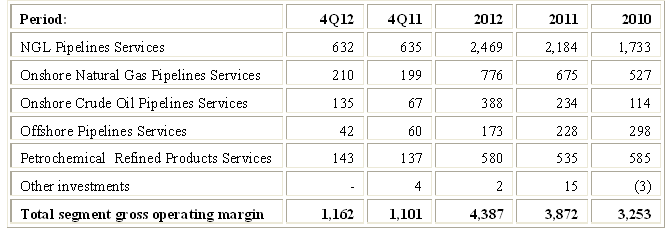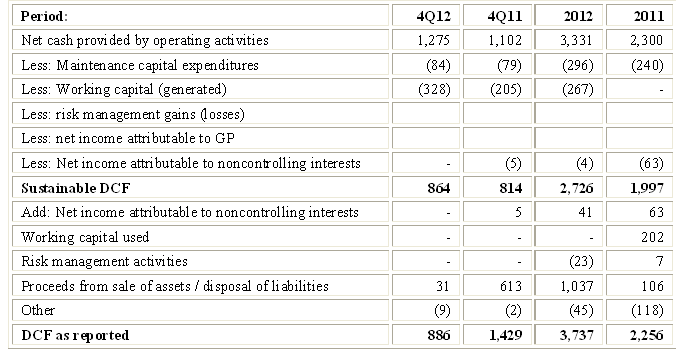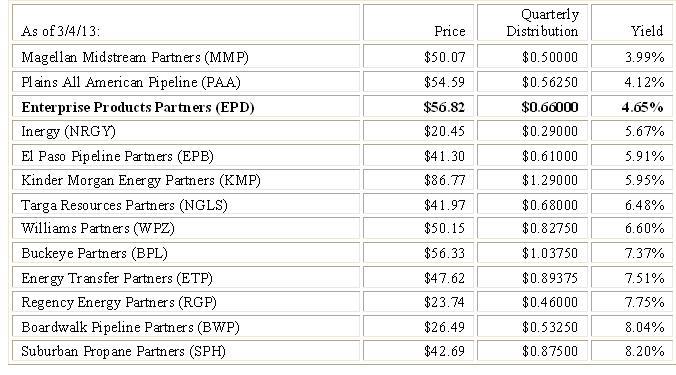On March 1, 2013, Enterprise Products Partners L.P. (EPD) provided its 2012 annual report on Form 10-K. Revenues, operating income, net income and earnings before interest, depreciation & amortization and income tax expenses (EBITDA) are summarized in Table 1:
Fluctuations in revenues and cost of sales amounts are explained in large part by changes in energy commodity prices, especially those for natural gas liquids (“NGL”), natural gas and crude oil. Energy commodity prices in 2012 were lower than they were in 2011 (by ~23% for NGLs, by ~31% for natural gas, and by ~1% for crude oil). Therefore, with one exception, segment revenues in 4Q12 and 2012 were down vs. the prior year periods, as seen in Table 2: 
However, lower revenues resulting from decreases in NGL, natural gas, crude oil and petrochemical prices were more than offset by lower costs of sales attributable to these decreases, hence, with one exception, the significant and impressive improvement in gross operating margins, as seen in Table 3 below:
The Offshore Pipeline Services segment underperformed in 2012 and is expected to continue to decline in 2013 because natural gas producers are switching more of their resources to increasing crude oil production (both onshore and offshore) and to increasing onshore NGL-rich natural gas production. EPD estimates average volumes on its largest offshore natural gas asset, the Independence Hub platform (80% owned by EPD), will approximate only 100 MMcf/d during 2013, a sharp decline from an average of 313 MMcf/d and 455 MMcf/d during 2012 and 2011, respectively. This will, hopefully, be somewhat offset by a recovery in crude oil volumes handled by EPB’s offshore Gulf of Mexico assets in 2013 from the lower volumes experienced since 2010.
Total segment gross operating margin in Table 3 above is defined by EPD as operating income before: (1) depreciation, amortization and accretion expenses; (2) non−cash asset impairment charges; (3) operating lease expenses for which it did not have the payment obligation; (4) gains and losses from sales of assets and investments; and (5) general and administrative costs.
In an article titled Distributable Cash Flow (“DCF”) I present the definition of DCF used by EPD and provide a comparison to definitions used by other master limited partnerships (“MLPs”). Using EPD’s definition, DCF for the trailing twelve month (“TTM”) period ending 12/31/12 was $4,133 million ($4.63 per unit), up from $3,737 in the comparable prior year period ($4.35 per unit). As always, I first attempt to assess how these figures compare with what I call sustainable DCF for these periods and whether distributions were funded by additional debt or issuing additional units.
The generic reasons why DCF as reported by the MLP may differ from what I call sustainable DCF are reviewed in an article titled Estimating Sustainable DCF-Why and How. Applying the method described there to EPD results through 12/31/12 generates the comparison outlined in Table 4 below: 
The principal differences between reported DCF and sustainable DCF relate working capital (in 2011) and to proceeds from asset sales.
In deriving reported DCF for 2011 management added back to net cash from operations $202 million of working capital used. Under EPD’s definition, reported DCF always excludes working capital changes, whether positive or negative. In contrast, as detailed in my prior articles, in deriving sustainable DCF I generally do not add back working capital used but, on the other hand, I exclude working capital generated. Despite appearing to be inconsistent, this makes sense because in order to meet my definition of sustainability the master limited partnerships should, on the one hand, generate enough capital to cover normal working capital needs. On the other hand, cash generated from working capital is not a sustainable source and I therefore ignore it. Over reasonably lengthy measurement periods, working capital generated tends to be offset by needs to invest in working capital. I therefore do not add working capital consumed to net cash provided by operating activities in deriving sustainable DCF.
Also, in deriving its reported DCF, EPD adds back proceeds from asset sales. In the TTM ending 12/31/12 these totaled $1,037 million, the largest component of which was generated by the sale of 29 million units of Energy Transfer Equity, LP (ETE) for $1,095 million between January and April, 2012. As readers of my prior articles are aware, I do not include proceeds from asset sales in my calculation of sustainable DCF.
Coverage ratios appear strong, and coverage was particularly impressive in 4Q12, as indicated in Table 5 below: 
I find it helpful to look at a simplified cash flow statement by netting certain items (e.g., acquisitions against dispositions) and by separating cash generation from cash consumption. Here is what I see for EPD:
Simplified Sources and Uses of Funds 
Net cash from operations, less maintenance capital expenditures, less cash related to net income attributable to non-controlling interests exceeded distributions by $333 million in the TTM ending 12/31/12 and by $999 million in the comparable prior year period. EPD is not using cash raised from issuance of debt and equity to fund distributions. The excess enables EPD to reduce reliance on the issuance of additional partnership units or debt to fund expansion projects.
EPD stated early in 2012 that it does not expect to be issuing equity in 2012. I nevertheless said in a prior article that I expect to see additional units issued by the end of 2012 in light of the increase in capital expenditure in 2012 and what’s coming up in 2013. While I was off somewhat on the timing (the issuance occurred on 2/5/13), I was pleased with the relatively modest number of EPD units issued (9.2 million, ~1% dilution). The issue was priced at $54.56 per unit and generated net cash proceeds of $486.6 million. The prior issuance of units occurred in September 2012 when EPD issued 10.4 million units at $53.07 per unit and generated total net cash proceeds of $473.3 million.
Overall, major capital projects in which EPD had invested $2.9 billion were completed and put into service in 2012 (i.e., started generating fee-based cash flows). Management expects to complete another $2.4 billion of project in 2013 and has an additional $4.8 billion of projects under construction that it expects to be completed in 2014 and the first half of 2015. The revenues from these projects will be predominantly fee-based and supported by long-term contracts.
EPD recently announced its 34th consecutive quarterly cash distribution increase to $0.66 per unit ($2.64 per annum), a 6.45% increase over the distribution declared with respect to the fourth quarter of 2011. EPD’s current yield is at the low end of the MLPs I follow: 
I think EPD’s premium price is justified on a risk-reward basis given EPD’s size, breadth of operations, strong management team, portfolio of growth projects, structure (no general partner incentive distributions), excess cash from operations, history of minimizing limited partner dilution and performance track record. The price drop to $50.75 cited in a prior article did, in fact, present a buying opportunity. I consider EPD to be a core MLP holding and would continue to accumulate on weakness.
- English (UK)
- English (India)
- English (Canada)
- English (Australia)
- English (South Africa)
- English (Philippines)
- English (Nigeria)
- Deutsch
- Español (España)
- Español (México)
- Français
- Italiano
- Nederlands
- Português (Portugal)
- Polski
- Português (Brasil)
- Русский
- Türkçe
- العربية
- Ελληνικά
- Svenska
- Suomi
- עברית
- 日本語
- 한국어
- 简体中文
- 繁體中文
- Bahasa Indonesia
- Bahasa Melayu
- ไทย
- Tiếng Việt
- हिंदी
A Closer Look: Enterprise Products Partners' Distributable Cash Flow
Published 03/06/2013, 06:02 AM
Updated 07/09/2023, 06:31 AM
A Closer Look: Enterprise Products Partners' Distributable Cash Flow
3rd party Ad. Not an offer or recommendation by Investing.com. See disclosure here or
remove ads
.
Latest comments
Install Our App
Risk Disclosure: Trading in financial instruments and/or cryptocurrencies involves high risks including the risk of losing some, or all, of your investment amount, and may not be suitable for all investors. Prices of cryptocurrencies are extremely volatile and may be affected by external factors such as financial, regulatory or political events. Trading on margin increases the financial risks.
Before deciding to trade in financial instrument or cryptocurrencies you should be fully informed of the risks and costs associated with trading the financial markets, carefully consider your investment objectives, level of experience, and risk appetite, and seek professional advice where needed.
Fusion Media would like to remind you that the data contained in this website is not necessarily real-time nor accurate. The data and prices on the website are not necessarily provided by any market or exchange, but may be provided by market makers, and so prices may not be accurate and may differ from the actual price at any given market, meaning prices are indicative and not appropriate for trading purposes. Fusion Media and any provider of the data contained in this website will not accept liability for any loss or damage as a result of your trading, or your reliance on the information contained within this website.
It is prohibited to use, store, reproduce, display, modify, transmit or distribute the data contained in this website without the explicit prior written permission of Fusion Media and/or the data provider. All intellectual property rights are reserved by the providers and/or the exchange providing the data contained in this website.
Fusion Media may be compensated by the advertisers that appear on the website, based on your interaction with the advertisements or advertisers.
Before deciding to trade in financial instrument or cryptocurrencies you should be fully informed of the risks and costs associated with trading the financial markets, carefully consider your investment objectives, level of experience, and risk appetite, and seek professional advice where needed.
Fusion Media would like to remind you that the data contained in this website is not necessarily real-time nor accurate. The data and prices on the website are not necessarily provided by any market or exchange, but may be provided by market makers, and so prices may not be accurate and may differ from the actual price at any given market, meaning prices are indicative and not appropriate for trading purposes. Fusion Media and any provider of the data contained in this website will not accept liability for any loss or damage as a result of your trading, or your reliance on the information contained within this website.
It is prohibited to use, store, reproduce, display, modify, transmit or distribute the data contained in this website without the explicit prior written permission of Fusion Media and/or the data provider. All intellectual property rights are reserved by the providers and/or the exchange providing the data contained in this website.
Fusion Media may be compensated by the advertisers that appear on the website, based on your interaction with the advertisements or advertisers.
© 2007-2024 - Fusion Media Limited. All Rights Reserved.
